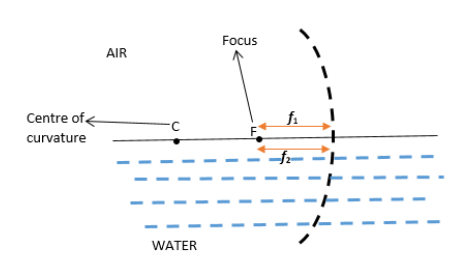
A concave mirror is half dipped in water. Focal length of the portion of mirror in the air is
A.
B.
C.
D.
Answer
515.7k+ views
Hint: The focal length of a mirror is a constant quantity. It does not change with medium nor does it depend on the refractive index of a medium. Hence, the focal length of the mirror in air is equal to the focal length of the mirror in the water.
Complete answer:
The distance from the centre of the mirror to the focal point is the focal length. Focal point for a concave mirror is the point on the optical axis on which light rays that are initially parallel to the optical axis converge after they reflect off the mirror. Now, since focal length is a distance, it is a constant quantity. It will not vary depending upon the medium. Hence, focal length of the concave mirror in air will be equal to the focal length of the concave mirror in water, that is,

The answer is option C.
Note:
The apparent depth of the mirror in water may appear less than the real depth when observed from air due to refraction of light. But this will not change the focal length of the mirror in any case. The focal length of the mirror is half of the radius of curvature. Since, the radius of curvature remains constant irrespective of the medium, focal length will also remain constant.
Complete answer:
The distance from the centre of the mirror to the focal point is the focal length. Focal point for a concave mirror is the point on the optical axis on which light rays that are initially parallel to the optical axis converge after they reflect off the mirror. Now, since focal length is a distance, it is a constant quantity. It will not vary depending upon the medium. Hence, focal length of the concave mirror in air will be equal to the focal length of the concave mirror in water, that is,

The answer is option C.
Note:
The apparent depth of the mirror in water may appear less than the real depth when observed from air due to refraction of light. But this will not change the focal length of the mirror in any case. The focal length of the mirror is half of the radius of curvature. Since, the radius of curvature remains constant irrespective of the medium, focal length will also remain constant.
Recently Updated Pages
Master Class 12 Business Studies: Engaging Questions & Answers for Success

Master Class 12 Economics: Engaging Questions & Answers for Success

Master Class 12 English: Engaging Questions & Answers for Success

Master Class 12 Maths: Engaging Questions & Answers for Success

Master Class 12 Social Science: Engaging Questions & Answers for Success

Master Class 12 Chemistry: Engaging Questions & Answers for Success

Trending doubts
Which are the Top 10 Largest Countries of the World?

What is transplantation in agriculture class 12 biology CBSE

Differentiate between homogeneous and heterogeneous class 12 chemistry CBSE

Why is the cell called the structural and functional class 12 biology CBSE

Hydrological cycle is controlled by A Grasslands B class 12 biology CBSE

Who discovered the cell and how class 12 biology CBSE




